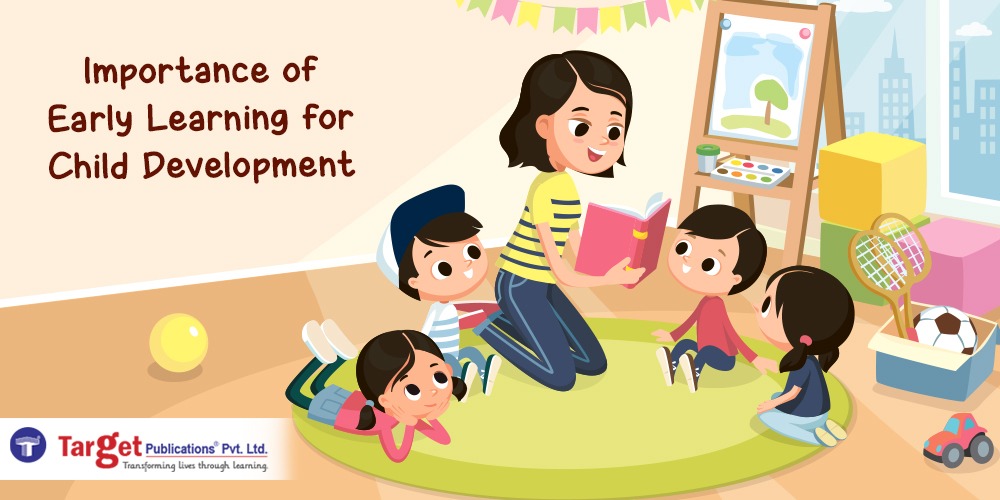Importance of Early Learning for Child Development

Did you know that during the period between infancy to age three, humans show the fastest rate of brain development in their lifetime?
What is early learning?
According to The National Institute of Child Health and Development, “early learning refers to the skills and concepts that children develop before they reach kindergarten. It is a crucial part of the development and can set patterns for both school and adult learning.”
The methods used for educating include both formal as well as informal ways of teaching children from birth all the way to the age of eight.
The role of early learning in a child’s development
Early learning affects more than just a child’s ability to learn the alphabet or numbers. It lays the foundation for emotional learning, social skills, building confidence, critical thinking, better coordination and creativity.
It is during their formative years that children develop their personalities and distinguish themselves from others. A strong sense of self goes a long way in tackling the world head-on.
Early learning at Home
Children are actively learning from the minute they are born. A child’s environment, family and daily life largely impact his or her ability to learn. Naturally, early learning begins at home and you, as a parent, hold the key to unlocking your child’s potential.
Every day is an opportunity to help him or her learn. Here are some ways you can promote early learning:
Talk to your child
Scientists have found that the children of parents who spoke to them frequently learned 200 more words than those who didn’t. Therein lays your first method of teaching. Talk to your child as much as possible; describe their surroundings, the flavour of food, discuss their emotions and so on.
Read to them
Even when your child is far from being able to recognise letters, books can be a great tool for early learning. You can read stories out loud to them during bedtime. It helps with learning the art of storytelling and helps them build their vocabulary. And let’s not forget how stories improve imagination and creativity too.
With the help of picture books and picture dictionaries, you can point and talk to your child about names, colours, shapes, sizes, numbers and places.
There are many interesting books you can read to your child. But it’s important that the books you read cover a plethora of topics, and are not solely based on fantasy.
As you read, point out the words and give your child time to absorb the accompanying illustrations to boost their comprehension.
Make use of Flashcards
Flashcards are an underrated and overlooked early learning tool. They can help little ones learn the alphabet, numbers, counting, new sounds and words. The large and brightly coloured illustrations arouse their curiosity to know more. Matching cards to what you call out for or playing other such games build your child’s problem-solving skills as well.
Hang charts
Charts offer a unique hands-on learning experience. They can be hung at strategic points in or around the house. Their large size and eye-catching pictures stimulate visual and tactile learning. Since they are constantly on display, looking at them daily facilitates easy recognition and understanding.
Play interactive games
Learning needs to be made fun or kids will adopt an aversion to it. Learning through play is stimulating and keeps children engaged for longer periods of time. Children already actively learn through observation and copying. What can be done additionally is to provide experiences that nurture learning in numerous ways.
Colourful building blocks develop logic. Dancing and running increase coordination. Playing games like eye-spy on your days out trigger object recognition. Simon says helps with learning actions. Treasure hunts engage all their senses.
Apart from cognitive learning, games also help kids learn how to lose, which is by far the most important thing to learn as a child. Not only does it build character but it also helps eradicate the fear of failure while encouraging them to try new things.
Art and Craft
Art and craft are other ways of learning in an entertaining manner. While engaging all the senses, it develops hand-eye coordination, fine motor skills and an eye for colour. Surprisingly, something as unassuming as crafting activities boosts critical thinking, problem-solving and pattern recognition in children.
Moreover, art and craft provide opportunities for hands-on learning of concepts that might be difficult. For example, a child is more likely to remember the planets of the solar system if he draws, colours, makes or pastes it rather than it being read out to him or her, or simply reading about it. And last but not least, art and craft play an irreplaceable role when it comes to self-expression for children.
In the process of teaching children, remember that each child is different and has their own pace of learning. It’s important to understand what type of early learning method your child responds to well and what doesn’t work for them. Keep your child’s interests in mind and be very patient with them.
A child’s learning starts from environmental cues and progresses to the barrel of knowledge contained in books. It’s crucial that their early learning is taken care of properly so they grow holistically into healthy, responsible, confident and empathetic adults.




